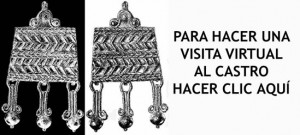BRONZE AGE
Around 800 B.C., in the highest part of the promontory of the Chao Samartín and next to the large rock, a group of people raise a large communal hut (55 m2), which in turn delimit and protect a timber palisade potent about 4 m. width.
Some scholars have wanted to see in these first few characters marked structures cultic and not domestic, given the findings in this area occurred in the course of archaeological excavations.
IRON AGE. THE "CASTREÑA" CULTURE
In Asturias, from the seventh century B. C. and until incorporation into the orbit of the Roman world, begin to emerge and develop a new type of fortified village, the hillforts.
They shall be located in the territory geostrategic locations, namely, in that territory where they can control and exploit the resources, commodity, defence and communications to enable their development.
Defend the forts with moats and walls mainly, defining and protecting an enclosure where the houses were lifted and other structures for community use.
In some hillforts, such as the Chao Samartín, the walls have a unique feature, are made of independent and juxtaposed segments or “modules”. Such walls were first defined by archaeologist and professor Dr. José Luis Maya González, in years 80 last century.
The model homes from this period are varied, from rectangular to rounded corners to circular, single space without partitioning, built with stone walls (Slate and Quartzite) and ceilings in plant material.
Open and covered plaza, the steam baths building (are already in Roman times) and paved streets are, inter alia, the most important community infrastructure of the town.
ROMAN TIMES
The arrival of the Romans to the hillfort means important changes and new features, which will manifest themselves in the structures and objects recovered from that moment. Some reflections of this new situation, is the arrival of objects and import products from distant lands, incorporating new habits and customs, the use of writing and currency, the partitioning of dwellings, the covering of the roofs with slate or the construction of a large house in the most pure and classical Roman style: the Domus.
This town, the ancient Ocela, see its sudden end to the mid-second century AD.
MIDDLE AGES
Between the seventh and tenth century and the space was located where the ancient Roman Domus, is located in a necropolis where men, women and children sought his last rest among the ruins of the old town. It is the last historic echo of relevance of this mound flattopped on the river Cabalos.


